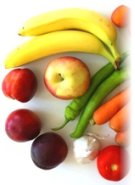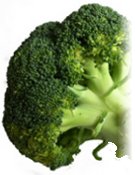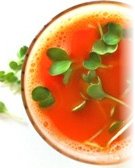How to Lose Body Fat With Food That Tastes Good
From ginger to cannellini beans, fat loss promoting foods are wide and varied. The trick is just to learn which foods contain nutrients that are good for fat loss, and which foods you might want to avoid during the diet. The purpose of this online guide to Fat Loss & Nutrition is to provide you with information and tips on how you can lose body fat with food – without compromising the taste of your meals.
Body fat is produced and stored by the body when we take in more calories than the body needs for general maintenance and its current level of physical activity. Most of the stored fat serves energy reservoir which is available for use when food is scarce. Of course, in modern Western countries, food is abundant, and large fat storages are not necessary. In fact, excess fat can have serious implications for health. Excess body fat is associated with numerous chronic diseases and conditions such as cardiovascular disease (particularly heart disease and stroke), type 2 diabetes, osteoarthritis, certain forms of cancer (endometrial, breast, and colon), hypertension (high blood pressure), high cholesterol, liver and gallbladder disease, sleep apnea, respiratory problems, abnormal menstrual flow, and infertility.
To combat these health problems, you can adopt either a weight loss diet or a fat loss diet. If your goal is to simply lose weight, you are also willing to lose muscle mass, which will lead to a less defined and toned physique. If you set your goal to lose fat but not muscle, you will not only dramatically decrease the risk of all diseases associated with overweight and obesity, but you will also gain a leaner looking body. Furthermore, a fat loss regimen – as opposed to a weight loss regimen – is more likely to keep the weight off in the long run.
Body fat percentage is commonly used to determine whether a person has too much body fat. Ideal body fat percentage depends on the person's age and sex. It is widely accepted that men should not have more than 18% total body fat and women not more than 23%. It is also important to recognize that striving for an extremely low body fat percentage is not healthy, either. This is because a certain amount of body fat is essential for the body to function normally. Such essential body fat accounts for 10-12% of total body fat for females and 3-5% for males. Women have more essential body fat because the female reproductive system requires more fat. Body fat percentage can be measured by body fat calipers, underwater weighting, or body fat scales.
To lose excess body fat, adopt a healthy exercise regimen – including plenty of cardio training – and a healthy nutrition plan that draws on the fat burning capabilities of food. To get you started on your path to a leaner body, we have compiled plenty of nutrition-related information, tips and tricks with your fat loss goals in mind:

Best Fat Loss Diet Plan to Blast Body Fat Naturally
In this section of HealWithFood.org's Guide to Fat Loss & Nutrition, you will learn how certain nutritional factors – such as avoidance of saturated fats, caloric restriction (especially in the evening), and a high intake of chromium and zinc – can help support your fat loss efforts.
View Diet Tips
The 30 Best Foods to Eat to Lose Body Fat
Learn how certain foods like ginger, cannellini beans, oatmeal, pine nuts, and egg whites can help you lose fat naturally, while maintaining muscle. As you'll see, most of these fat loss foods are inexpensive household items that can be found at your local grocery store.
View Food List
Recipes for Healthy & Tasty Fat Loss Meals
Are you ready for some low calorie carrot & fennel salad that is also packed with fiber and fat-burning vitamin C? Or how about a bowl of fat-burning tomato soup that is loaded with chromium, a mineral that helps maintain lean body mass? The recipe section of our Fat Loss & Nutrition Guide will help you put in practice the diet and food related tips you have learned in the earlier sections.
View Recipes
